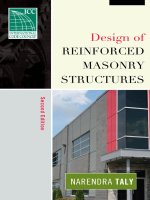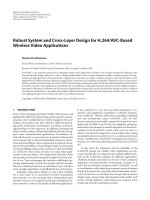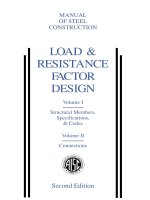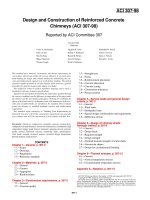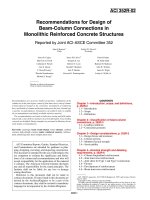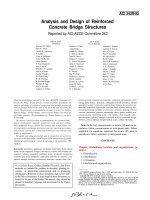development of load and resistance factor design for frp strengthening of reinforced concrete structures
Bạn đang xem bản rút gọn của tài liệu. Xem và tải ngay bản đầy đủ của tài liệu tại đây (12.31 MB, 422 trang )
UNIVERSITY OF CALIFORNIA, SAN DIEGO
Development of Load and Resistance Factor Design for
FRP Strengthening of Reinforced Concrete Structures
A dissertation submitted in partial satisfaction of the
requirements for the degree Doctor of Philosophy
in
Structural Engineering
by
Rebecca Anne Atadero
Committee in Charge:
Professor Vistasp M. Karbhari, Chair
Professor Gilbert A. Hegemier
Professor Francesco Lanza di Scalea
Professor Marc A. Meyers
Professor Jeffrey M. Rabin
2006
UMI Number: 3210643
3210643
2006
UMI Microform
Copyright
All rights reserved. This microform edition is protected against
unauthorized copying under Title 17, United States Code.
ProQuest Information and Learning Company
300 North Zeeb Road
P.O. Box 1346
Ann Arbor, MI 48106-1346
by ProQuest Information and Learning Company.
Copyright
Rebecca Anne Atadero, 2006
All rights reserved.
The dissertation of Rebecca Anne Atadero is approved,
and it is acceptable in quality and form for publication
on microfilm:
__________________________________________________
__________________________________________________
__________________________________________________
__________________________________________________
__________________________________________________
Chair
University of California, San Diego
2006
iii
DEDICATION
To my husband, Todd, maybe I could have done it without you, but I am sure glad that I didn’t
have to. You are my sunshine and I love you!
iv
TABLE OF CONTENTS
Signature Page iii
Dedication iv
Table of Contents v
List of Figures xviii
List of Tables xxi
Acknowledgements xxvi
Vita xxvii
Abstract xxviii
Chapter 1. Introduction 1
1.1 Overview 1
1.2 FRPs for Strengthening of Civil Structures 1
1.2.1 Fiber Reinforced Polymer Composites 1
1.2.2 Strengthening and Repair of Civil Structures 2
1.2.3 Advantages of FRPs for Strengthening 4
1.2.4 Disadvantages of FRPs for Strengthening 5
1.3 Design Code for FRP Strengthening 5
1.3.1 Need for a Design Code 5
1.3.2 Uncertainty in Structural Design 7
1.3.3 Design Philosophies as the Basis for Design Codes 7
1.3.3.1 Working Stress Design 8
1.3.3.2 Load and Resistance Factor Design 8
1.3.3.3 Advantages of LRFD 10
1.3.4 Current Design Guidelines for FRP Strengthening 11
v
1.4 Problem Statement and Research Objectives 13
1.4.1 Problem Description 13
1.4.2 Research Objectives 15
1.4.3 Research Approach 16
1.4.4 Outline of the Dissertation 19
Chapter 2. Background for Structural Reliability, LRFD and Design Uncertainty 22
2.1 Introduction 22
2.2 Structural Reliability Methods 22
2.2.1 Uncertainty and Risk 22
2.2.2 Evaluation of Structural Reliability 24
2.2.2.1 Effect of Uncertainty 24
2.2.2.2 Deterministic Safety Factors 25
2.2.2.3 Basic Reliability Problem 26
2.2.2.4 The Reliability Index 29
2.2.2.5 Methods of Computing the Reliability Index 32
2.2.2.5.1 First-Order, Second-Moment Reliability Index 32
2.2.2.5.2 First- and Second-Order Reliability Methods (FORM and
SORM)… 33
2.2.2.5.3 Monte Carlo Simulation (MCS) 34
2.2.2.5.4 Other Techniques 35
2.2.2.6 Levels of Reliability Methods 35
2.2.2.7 Component vs. System Reliability 36
2.2.2.8 Time-dependent Reliability 37
2.2.2.9 Limitations of Reliability Methods 38
vi
2.2.2.10 Reliability Methods Used for This Dissertation 39
2.3 Previous Development of LRFD 41
2.3.1 Steel 41
2.3.2 Loads 42
2.3.3 Engineered Wood 43
2.3.4 Bridges 43
2.3.5 Concrete 45
2.3.6 Aspects of Existing Codes Considered in this Work 45
2.4 Previous Work on Reliability of FRP in Civil Infrastructure 46
2.4.1 FRP for Strengthening 46
2.4.1.1 Limitations of Existing Studies 49
2.4.2 FRP for New Construction 50
2.4.2.1 General Design Standards 51
2.5 Statistical Descriptors for Resistance Variables 52
2.5.1 Concrete 53
2.5.2 Reinforcing Steel 55
2.5.3 Dimensions 56
2.5.3.1 Area of Steel 57
2.5.3.2 Slab Dimensions 57
2.5.3.3 Beam Dimensions 57
2.5.4 Modeling Uncertainty 58
2.6 Description of Load Variables 60
2.6.1 Dead Load 61
2.6.2 Live and Impact Loads 61
vii
2.7 Consideration of Continued Degradation 68
2.7.1 Modes of Reinforced Concrete Degradation 68
2.7.2 Corrosion of Steel in Concrete 69
2.7.2.1 Carbonation-Induced Corrosion 71
2.7.2.2 Chloride-Induced Corrosion 72
2.7.2.3 Rates of Corrosion 72
2.7.3 Previous Work Modeling Corrosion-Induced Degradation in Bridges 74
2.7.4 Corrosion Models Used in this Dissertation 76
2.7.4.1 Major Assumptions for Corrosion Modeling 76
2.7.4.2 Mathematical Models for Corrosion 78
2.8 Target Reliability Index 81
2.8.1 Comparison to Other Acceptable Levels of Risk 82
2.8.2 Optimization of Cost-Benefit 83
2.8.3 Empirical Approaches 83
2.8.4 Calibration to Safety Levels Implied by Existing Codes 86
2.8.4.1 Reliability Indices from Other LRFD Codes 87
2.8.5 Selection of Target β for this Work 90
2.9 Discussion of Background Data 92
Chapter 3. Characterization of Composite Properties for Reliability Analysis and Design 94
3.1 Introduction 94
3.2 Description of Data Sets 95
3.2.1 Testing Procedures 95
3.2.2 Wet Layup Composites 95
3.3 Characterization of Random Variation 98
viii
3.3.1 A Note on the Effect of Thickness 98
3.3.2 Basic Statistics 99
3.3.3 Statistical Distributions for Representing Composite Properties 104
3.3.3.1 Distributions 104
3.3.3.2 Distributions Fit to Wet Layup Composite Data 107
3.3.4 Best Fitting Distributions 111
3.3.4.1 Strength 112
3.3.4.2 Modulus 114
3.3.4.3 Thickness 116
3.3.4.4 Summary of Distributions for Reliability Analysis 118
3.3.5 Correlation between Variables 119
3.4 Design Values for Composite Materials 121
3.4.1 Current Approaches to Selection of Design Values 121
3.4.1.1 Reliability Implications of Current Design Approach 123
3.4.2 Proposed Approach to Design Values 128
3.4.2.1 Accounting for Material Variability 128
3.4.2.2 Use of the Mean as the Characteristic Value 130
3.4.2.3 Factors for Systematic Variation and Time-Dependent Behavior 131
3.4.2.4 Promoting Reliability-Based Design 131
3.5 Characterizing and Accounting for Systematic Differences between Laboratory
Derived Design Values and In-Situ Properties 133
3.5.1 Currently Used Factors 133
3.5.2 Types of Systematic Variation 136
3.5.3 Proposed Set of Application Factors 137
ix
3.5.4 Values of Factors for Wet Layup Composites 139
3.5.4.1 Consideration of Thickness 140
3.5.4.2 Values for
λ
pred
140
3.5.4.2.1 Predicted Value Based on Constitutive Properties 140
3.5.4.2.2 Predicted Value Based on Manufacturer Data 147
3.5.4.2.3 Predicted Value Based on Lamina or Laminate Level Tests 149
3.5.4.3 Values for
λ
layers
149
3.5.4.4 Values for
λ
cure
151
3.5.4.5 Values for
λ
work
152
3.5.4.6 Summary of Factors for Systematic Variation of Wet Layup
Composites. 153
3.5.4.7 Assessment of Factor Accuracy 154
3.6 Time-Dependent Degradation of FRP Properties 159
3.6.1 Current Approaches to Considering Time-Dependent Behavior of FRP
Properties 159
3.6.1.1 Environmental Exposure 159
3.6.1.2 Sustained and Fatigue Loading 161
3.6.2 Proposed Method for Consideration of Time-Dependent Degradation of FRP
Properties 162
3.6.2.1 Factor for Environmental Degradation 162
3.6.2.1.1 Advantages of this Approach 165
3.6.2.1.2 Limitations of Proposed Approach 166
3.6.2.2 Stress Limitations for Sustained and Fatigue Loading 167
3.6.2.2.1 Sustained Loading 167
x
3.6.2.2.2 Fatigue loading 167
3.7 Summary 169
Chapter 4. Calibration of Resistance Factors for Flexural Strengthening of Bridge Girders. 171
4.1 Introduction 171
4.2 Procedure for Calibration of Resistance Factors 171
4.3 Summary of Previous Calibration Work 175
4.3.1 Load Factors for Strengthening Design (Section C.5) 175
4.3.2 Large Example Calibration without Corrosion (Section C.6) 176
4.3.3 Example with Corrosion (Section C.8) 178
4.4 Range of Calibration 178
4.4.1 Composite Materials 179
4.4.1.1 Initial Properties 179
4.4.1.2 States of FRP Degradation 180
4.4.2 Representative Members for Calibration 181
4.4.2.1 Typical Bridge Dimensions 184
4.4.2.2 Selected Girders 185
4.4.3 Time Periods Considered 190
4.4.4 Cases of Continued Degradation 190
4.5 Design of Strengthening 191
4.5.1 Calculation of Design Load 192
4.5.2 Calculation of Resistance 197
4.5.2.1 Debonding Model 198
4.5.3 Computational Procedure 200
4.5.4 Summary of Designs 201
xi
4.6 Calculation of Reliability 201
4.6.1 Description of Load Uncertainty 202
4.6.2 Description of Resistance Uncertainty 205
4.6.3 Calculation Procedures 207
4.6.3.1 Simulation of Resistance 207
4.6.3.1.1 Convergence 208
4.7 Results 209
4.7.1 Procedures Used to Analyze Reliability Results 209
4.7.2 Effect of the Amount of Remaining Steel 211
4.7.2.1 Significance 219
4.7.3 Effect of No Continuing Corrosion vs. Continuing Corrosion 220
4.7.3.1 Significance 222
4.7.4 Effect of Different FRP Degradation Models 223
4.7.4.1 Significance 225
4.7.5 Effect of Different Materials 226
4.7.5.1 Significance 227
4.8 Extensions on the Large Calibration Example 227
4.8.1 Effect of Changes in Modulus COV 227
4.8.1.1 Results 228
4.8.2 Effect of Different Bond Models 230
4.8.2.1 Results 231
4.9 Summary 232
Chapter 5. Recommended Design Procedure and Design Example 234
5.1 Proposed Design Procedure 234
xii
5.1.1 Assess the Existing Structure 235
5.1.2 Define the Objectives and Parameters for Strengthening 235
5.1.3 Determine Design Values for the Composite 236
5.1.4 Select Appropriate Resistance Factors 237
5.1.5 Calculate the Amount of FRP Needed to Meet the Design Objective 239
5.1.6 Perform Final Checks on the Design 240
5.1.7 Specify Appropriate Quality Control Measures to be Followed During
Application of FRP 240
5.2 Design Example 240
5.2.1 Structural Assessment 241
5.2.2 Objectives and Parameters for Strengthening 241
5.2.3 Composite Design Values 242
5.2.4 Selection of Resistance Factors 245
5.2.5 Calculating the Required Area of FRP 249
5.2.6 Check the Stress in the FRP under Sustained Loads 254
5.3 Reliability Assessment of Design Example 254
5.4 Summary 256
Chapter 6. Conclusions and Areas for Further Study 257
6.1 Summary 257
6.2 Areas for Further Study 257
6.2.1 FRP Composite Material Properties and Design Factors 258
6.2.1.1 Statistical Description of Properties 258
6.2.1.2 Prefabricated Composites 259
6.2.1.3 Application Factors 260
xiii
6.2.1.4 Degradation Models 260
6.2.2 Limit States for Evaluation 260
6.2.2.1 Flexure 261
6.2.2.2 Shear 261
6.2.2.3 Slabs 262
6.2.2.4 Serviceability 262
6.2.2.5 Modeling Error 262
6.2.2.6 Interaction of Limit States 262
6.2.3 Statistical Models of Load 263
6.2.4 Modeling Continued Structural Degradation 264
6.2.5 Time-Dependent Reliability 264
6.2.6 Selection of β
T
265
6.2.7 Understanding the State of the Existing Structure 265
6.3 Conclusion 266
Appendix A. Live Load Statistics for Specified Design Life 267
A.1 Introduction to Problem 267
A.2 Attempted Derivation of Extreme Value Distribution 267
A.2.1 Basic Distribution of the Maximum 267
A.2.2 Attempted Use of Distribution of the Maximum 268
A.3 Different Methods Used to Assess Time-Dependent Reliability 272
A.3.1 Definition of Trial Conditions 272
A.3.2 Trial Calculation Techniques and Results 273
A.4 Conclusions 276
Appendix B. Goodness-of-Fit Tests 278
xiv
B.1 Introduction 278
B.2 Chi-Squared Test 278
B.3 EDF Tests 279
B.3.1 Kolmogorov-Smirnov Test 280
B.3.2 Anderson-Darling Test 280
Appendix C. Preliminary Calibration Examples 282
C.1 Introduction 282
C.2 Sample Girder 282
C.3 General Procedure for Strengthening Design 284
C.4 Composite Material Properties for Calibration 285
C.5 Load Factors for Use in Strengthening Design 287
C.6 Large Example Calibration without Corrosion 290
C.6.1 Description of Procedures and Variables 291
C.6.1.1 Degraded Structure 291
C.6.1.2 FRP Properties 291
C.6.1.3 Degraded Properties 292
C.6.1.4 Designs 293
C.6.1.5 Reliability Analysis 293
C.6.1.6 Time-Dependent Reliability 295
C.6.1.7 Load Variables 295
C.6.1.8 Resistance Variables 297
C.6.2 Results of Sample Calibration without Corrosion 298
C.6.2.1 Effect of Reliability Calculation Method 298
C.6.2.2 Effect of Different Amounts of Steel Loss 302
xv
C.6.2.3 Effect of Time Span for Evaluation 304
C.6.2.4 Effect of Differences in Mean Value of FRP Properties 308
C.6.2.5 Effect of Changes in Modulus Coefficient of Variation 312
C.6.2.6 Effect of Changes in Strength Coefficient of Variation 315
C.7 Effect of Resistance Variables Considered in Reliability Analysis 316
C.8 Example with Corrosion 318
C.8.1 Design Philosophy 318
C.8.2 Degraded Structure 319
C.8.3 Prediction of Remaining Steel 320
C.8.4 FRP Properties 321
C.8.5 Design of Strengthening 322
C.8.6 Reliability Analysis 322
C.8.7 Random Variables 322
C.8.8 General vs. Pitting Corrosion 323
C.8.9 Results of Sample Calibration with Corrosion 324
C.9 Summary of Conclusions from Sample Calibrations 326
Appendix D. Sectional Analysis 328
D.1 Introduction 328
D.2 RC Section without FRP 328
D.3 RC Section with Externally Bonded FRP 330
Appendix E. Techniques Used in Reliability Assessment 336
E.1 Monte Carlo Simulation 336
E.2 Generating Random Numbers from a Statistical Distribution 339
E.3 Implementation of FORM 341
xvi
Appendix F. Java Programs 344
F.1 Program for Design of Strengthening 344
F.1.1 Variables 344
F.1.2 Procedure 346
F.1.3 Code 347
F.2 Program for Simulation and Evaluation of Resistance Statistics 353
F.2.1 Variables 354
F.2.2 Procedure 355
F.2.3 Code 356
Appendix G. Data from Bridge Survey 366
G.1 Summary of Dimensions Collected 366
Appendix H. Load Analysis in QConBridge™ 379
H.1 Program Description 379
H.2 Input Details for Calibration Girders 381
References 385
xvii
LIST OF FIGURES
Figure 1-1 Components of Reliability Based Design for FRP Strengthening 17
Figure 2-1 Basic Structural Reliability Problem 25
Figure 2-2 Graphical Representation of Probability of Failure 28
Figure 2-3 Interpretation of
β
in Terms of the Safety Margin 31
Figure 2-4 Design Truck for HS-20 and HL-93 Load Models 64
Figure 2-5 Tuutti’s (1982) Model for Sequence of Steel Corrosion in Concrete 70
Figure 2-6 Relation between Concrete Compressive Strength and Water-Cement Ratio 80
Figure 3-1 Plot of Cumulative Distribution Functions for Set A1 Strength 111
Figure 3-2 Changes in
β
with Additional Required Strengthening 128
Figure 3-3 Ratio of Tested Strength to Predicted Strength vs. Fiber Volume Fraction for One-
Layer Samples 144
Figure 3-4 Ratio of Tested Strength to Predicted Strength vs. Fiber Volume Fraction for One-
Layer Samples Without Set E1 145
Figure 3-5 Ratio of Tested Modulus to Predicted Modulus vs. Fiber Volume Fraction for One-
Layer Samples 146
Figure 4-1 Basic Flowchart for Calibration Procedure 173
Figure 4-2 Histogram of Bridge Spans 184
Figure 4-3 Histogram of Number of Girders 185
Figure 4-4 Histogram of Deck Width 185
Figure 4-5 Plot of Convergence of Monte Carlo Results as a Function of the Number of Trials
209
Figure 4-6 Example of Plots Used to Select Calibrated Resistance Factors 210
Figure 4-7
ψ
vs. Strength COV for Girder 18, Corrosion Condition 4, SD,
β
T
= 3.5, and
φ
=
0.85 218
Figure A-1 PDF of Bias Factor for Maximum Load for Different Time Spans 269
Figure A-2 CDF of Bias Factor for Maximum Load for Different Time Spans 270
xviii
Figure A-3 Comparison of Distributions for Mean Maximum 50-Year Load Bias Factor 271
Figure C-1
β
vs.
ψ
for Material 1 Designs to Meet LRFD and LRFR Loads 290
Figure C-2 Monte Carlo Results for 20% Steel Loss, Strength COV = 0.25, Modulus COV
=0.05, 0 degradation, 75 year loads 299
Figure C-3 Hybrid Results for 20% Steel Loss, Strength COV = 0.25, Modulus COV = 0.05,
0 degradation, 75 year loads 300
Figure C-4 Monte Carlo Results for 30% Steel Loss, Strength COV = 0.25, Modulus COV =
0.05, 0 degradation, 75 year loads 301
Figure C-5 Hybrid Results for 30% Steel Loss, Strength COV = 0.25, Modulus COV = 0.05,
0 degradation, 75 year loads 301
Figure C-6 Hybrid Results for 20% Steel Loss, Strength COV = 0.15, Modulus COV = 0.15,
no degradation, 75 year loads 305
Figure C-7 Hybrid Results for 20% Steel Loss, Strength COV = 0.15, Modulus COV = 0.15,
5-year exposure, 5 year loads 305
Figure C-8 Hybrid Results for 20% Steel Loss, Strength COV = 0.15, Modulus COV = 0.15,
50-year exposure, 50 year loads 306
Figure C-9 Hybrid Results for 20% Steel Loss, Strength COV = 0.15, Modulus COV = 0.15,
5-year exposure, 5 year loads 307
Figure C-10 Hybrid Results for 30% Steel Loss, Strength COV = 0.25, Modulus COV = 0.05,
5-year exposure, 5 year loads 309
Figure C-11 Hybrid Results for 30% Steel Loss, Strength COV = 0.25, Modulus COV = 0.05,
50-year exposure, 50 year loads 310
Figure C-12 Hybrid Results for 20% Steel Loss, Strength COV = 0.25, Modulus COV = 0.05,
5-year exposure, 5 year loads 313
Figure C-13 Hybrid Results for 20% Steel Loss, Strength COV = 0.25, Modulus COV = 0.15,
5-year exposure, 5 year loads 314
Figure C-14 Hybrid Results for 20% Steel Loss, Strength COV = 0.25, Modulus COV = 0.25,
5-year exposure, 5 year loads 314
Figure C-15
ψ
as a function of Strength COV for 20% Steel Loss and Modulus COV =15%
315
Figure C-16
ψ
as a function of Strength COV for 30% Steel Loss and Modulus COV =15%
316
xix
Figure C-17 Effect of Using Different Cases of Random Variables to Assess Reliability for
Material 2 Designs 318
Figure C-18 Reliability Index vs. Composite Specific Resistance Factor for Material 1,
φ
=
0.90, 324
Figure D-1 Forces in a Rectangular Section at Ultimate (Only Steel Reinforcement) 329
Figure D-2 Forces in a Rectangular Section (Steel and FRP Reinforcement) 331
Figure E-1 Flow Chart of Monte Carlo Simulation 337
Figure H-1 Example of Bridge Model for Girder 12 (not to scale) 384
xx
LIST OF TABLES
Table 1-1 Questions to be Answered in LRFD Development 18
Table 2-1 Probabilities of Failure and Corresponding
β
s 32
Table 2-2 Comparison of Live Load Factors for Inventory and Operating Levels 44
Table 2-3 Distribution Properties for Slab Dimensions 57
Table 2-4 Distribution Properties for Beam Dimensions 58
Table 2-5 Comparison of HS-20 and HL-93 Load Models for Calculation of Maximum
Positive Moment 63
Table 2-6 Ratio of Mean Maximum Moments to HL-93 Moments 65
Table 2-7 Causes of Deterioration of Concrete (Bertolini et al., 2004) 68
Table 2-8 Rates of Corrosion Penetration of Steel in Concrete (Bertolini et al., 2004) 73
Table 2-9 Rates of Corrosion Penetration Based on Concrete Cover and Exposure Condition74
Table 2-10 Approximate Relation between Concrete Strength and Water-Cement Ratio 79
Table 2-11 Comparison of Common Risks and Structural Failure Probabilities 82
Table 2-12 Target Failure Probabilities and Reliability Indices Based on CIRIA 84
Table 2-13 Target Failure Probabilities and Reliability Indices Based on Allen (1981) W=0.1
85
Table 2-14 Target Reliability Levels and Corresponding Lifetime Probabilities of Failure from
Nordic Report 86
Table 2-15 Target Reliability Indices and Corresponding Annual Probabilities of Failure for
Other Structural Design Codes 88
Table 2-16 Adjustments to Target Reliability for Canadian Bridge Evaluation 90
Table 3-1 Summary of Wet Layup Data Sets 98
Table 3-2 Descriptive Statistics for Ultimate Tensile Strength 100
Table 3-3 Descriptive Statistics for Longitudinal Modulus 102
Table 3-4 Descriptive Statistics for Thickness 103
xxi
Table 3-5 Distribution Parameters for Ultimate Tensile Strength 108
Table 3-6 Distribution Parameters for Longitudinal Modulus 109
Table 3-7 Distribution Parameters for Composite Thickness 110
Table 3-8 Chi-Squared Goodness-of-Fit Results for Strength 112
Table 3-9 Kolmogorov-Smirnov Goodness-of-Fit Results for Strength, α=0.10 113
Table 3-10 Anderson-Darling Goodness-of-Fit Results for Strength, α= 0.25 114
Table 3-11 Chi-Squared Goodness-of-Fit Results for Modulus 115
Table 3-12 Kolmogorov-Smirnov Goodness-of-Fit Results For Modulus, α=0.10 115
Table 3-13 Anderson Darling Goodness-of-Fit Results for Modulus, α=0.10 116
Table 3-14 Chi-Squared Goodness-of-Fit Results for Thickness 117
Table 3-15 Kolmogorov-Smirnov Goodness-of-Fit Results for Thickness, α=0.10 117
Table 3-16 Anderson-Darling Goodness-of-Fit Results for Thickness, α= 0.25 118
Table 3-17 Correlation Coefficients for Wet Layup Composites 121
Table 3-18 Different Ways of Specifying the Characteristic Value for FRP Strength 123
Table 3-19 Properties of Model Composite 125
Table 3-20 Reliability of Designs Using Different COVs for Strength 125
Table 3-21 Basic Description of System of Application Factors 139
Table 3-22 Properties of Fibers and Matrices for Prediction of Strength and Modulus 141
Table 3-23 Mean and COV of Ratio of Tested Values to Values Predicted Using Properties of
Fiber and Matrix for Strength 142
Table 3-24 Mean and COV of Ratio of Tested Values to Values Predicted Using Properties of
Fiber and Matrix for Modulus 142
Table 3-25 Manufacturer Properties for Sets E and F 147
Table 3-26 Ratio of Tested Properties to Manufacturer-Reported Properties 148
Table 3-27
λ
layers
for Strength and Modulus 151
Table 3-28 Generalized
λ
layers
for Design 151
xxii
Table 3-29 Preliminary Values of Application Factors for Wet Layup Composites 154
Table 3-30 Mean and COV of Ratio of Tested to Predicted Force per Unit Width 155
Table 3-31 Mean and COV of Ratio of Tested to Predicted Stiffness per Unit Width 156
Table 3-32 Mean and COV of Ratio of Tested to Predicted Force per Unit Width 157
Table 3-33 Mean and COV of Ratio of Tested to Predicted Stiffness per Unit Width 157
Table 3-34 Stress Limitations as Percentage of Ultimate Strength 161
Table 3-35 Predictive Equations for Property Retention Based on an Arrhenius Rate Relation
(Abanilla, 2004) 165
Table 4-1 LRFR Load Factors for Design of Strengthening (AASHTO, 2003) 176
Table 4-2 Generalized Composite Properties Used for Calibration 180
Table 4-3 Bridge Quantities Surveyed to Determine Common Values for Calibration 183
Table 4-4 Geometry of Representative Bridges for Calibration 187
Table 4-5 Comparison of Distribution of Span Lengths for Selected Bridges 188
Table 4-6 Comparison of Distribution of Number of Girders for Selected Bridges 188
Table 4-7 Comparison of Distribution of Deck Widths for Selected Bridges 189
Table 4-8 Comparison of QConBridge™ and CT-BDS for Selected Girders 193
Table 4-9 Load Components and LRFR Factored Load for Design 196
Table 4-10 Distribution Parameters of Load for Reliability Analysis 204
Table 4-11 Statistical Distributions Used in Reliability Analysis 206
Table 4-12 Baseline LRFR Steel Areas and Steel Areas for Each Corrosion Condition in mm
2
(in.
2
) 213
Table 4-13 Summary of Resistance Factors for Different Target Reliabilities and Different
Amounts of Relative Steel Loss 217
Table 4-14 Example of Calibrated
ψ
for Girder 15, Corrosion Case 2, with FRP Degradation
221
Table 4-15 Example of Calibrated
ψ
for Girder 3, Corrosion Case 5, with FRP Degradation
222
xxiii
Table 4-16 Example of Calibrated
ψ
for Girder 5, Corrosion Case 2 224
Table 4-17 Example of Calibrated
ψ
for Girder 14, Corrosion Case 4 225
Table 4-18 Comparison of Calibrated Resistance Factors with Changes in Strength and
Modulus COVs for Girder 16, Corrosion Condition 4,
β
T
= 3.5,
φ
= 0.85 229
Table 4-19 Example of Calibrated
ψ
for Girder 4, β = 3.0, Corrosion Condition 1,
φ
= 0.9, AD
232
Table 4-20 Example of Calibrated
ψ
for Girder 4, β = 3.0, Corrosion Condition 2,
φ
= 0.9, AD
232
Table 5-1 Approximate Values for COV
characteristic
for Wet Layup Composites Based on Testing
239
Table 5-2 Dimensions and Material Properties of Girder 15 241
Table 5-3 Results from Lamina Level Tests 242
Table 5-4 Preliminary Values of Application Factors for Wet Layup Composites 243
Table 5-5 Resistance Factors for Design Example 248
Table 5-6 Final Design Quantities 254
Table 5-7 Statistical Distributions for Set A1 used in Reliability Analysis 255
Table A-1 Comparison of Estimated Bias Factors and Bias Factors from NCHRP Report 368
270
Table A-2 Basic Details of Strengthening Example 273
Table A-3 Different Methods Used to Calculate Time-Dependent Reliability 274
Table A-4 Comparison of Reliabilities for Different Computation Techniques 275
Table C-1 Bridge Deck Dimensions 283
Table C-2 Load Effects for Girder Design 283
Table C-3 Dimensions of Sample Girder 284
Table C-4 Mean Property Values of Sample Composites 288
Table C-5 Mean Property Values of Sample Composites 292
Table C-6 Percent Retention of FRP Properties for Different Design Lives 293
xxiv
